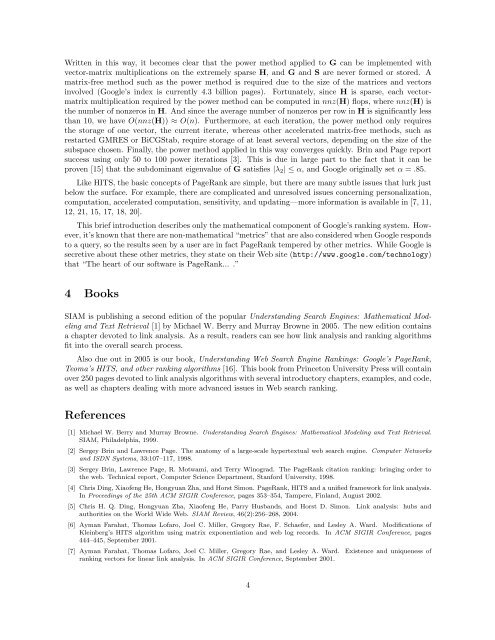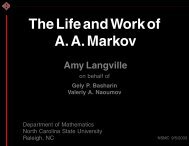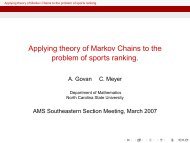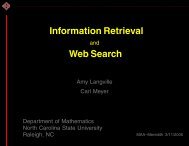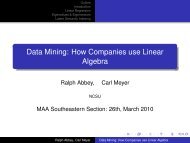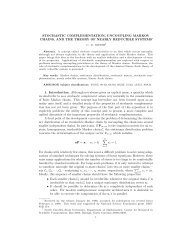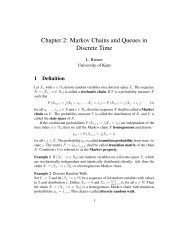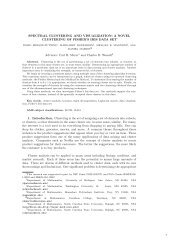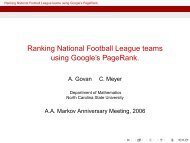The Use of the Linear Algebra by Web Search Engines - Carl Meyer
The Use of the Linear Algebra by Web Search Engines - Carl Meyer
The Use of the Linear Algebra by Web Search Engines - Carl Meyer
You also want an ePaper? Increase the reach of your titles
YUMPU automatically turns print PDFs into web optimized ePapers that Google loves.
Written in this way, it becomes clear that <strong>the</strong> power method applied to G can be implemented withvector-matrix multiplications on <strong>the</strong> extremely sparse H, and G and S are never formed or stored. Amatrix-free method such as <strong>the</strong> power method is required due to <strong>the</strong> size <strong>of</strong> <strong>the</strong> matrices and vectorsinvolved (Google’s index is currently 4.3 billion pages). Fortunately, since H is sparse, each vectormatrixmultiplication required <strong>by</strong> <strong>the</strong> power method can be computed in nnz(H) flops, where nnz(H) is<strong>the</strong> number <strong>of</strong> nonzeros in H. And since <strong>the</strong> average number <strong>of</strong> nonzeros per row in H is significantly lessthan 10, we have O(nnz(H)) ≈ O(n). Fur<strong>the</strong>rmore, at each iteration, <strong>the</strong> power method only requires<strong>the</strong> storage <strong>of</strong> one vector, <strong>the</strong> current iterate, whereas o<strong>the</strong>r accelerated matrix-free methods, such asrestarted GMRES or BiCGStab, require storage <strong>of</strong> at least several vectors, depending on <strong>the</strong> size <strong>of</strong> <strong>the</strong>subspace chosen. Finally, <strong>the</strong> power method applied in this way converges quickly. Brin and Page reportsuccess using only 50 to 100 power iterations [3]. This is due in large part to <strong>the</strong> fact that it can beproven [15] that <strong>the</strong> subdominant eigenvalue <strong>of</strong> G satisfies |λ 2 |≤α, and Google originally set α = .85.Like HITS, <strong>the</strong> basic concepts <strong>of</strong> PageRank are simple, but <strong>the</strong>re are many subtle issues that lurk justbelow <strong>the</strong> surface. For example, <strong>the</strong>re are complicated and unresolved issues concerning personalization,computation, accelerated computation, sensitivity, and updating—more information is available in [7, 11,12, 21, 15, 17, 18, 20].This brief introduction describes only <strong>the</strong> ma<strong>the</strong>matical component <strong>of</strong> Google’s ranking system. However,it’s known that <strong>the</strong>re are non-ma<strong>the</strong>matical “metrics” that are also considered when Google respondsto a query, so <strong>the</strong> results seen <strong>by</strong> a user are in fact PageRank tempered <strong>by</strong> o<strong>the</strong>r metrics. While Google issecretive about <strong>the</strong>se o<strong>the</strong>r metrics, <strong>the</strong>y state on <strong>the</strong>ir <strong>Web</strong> site (http://www.google.com/technology)that “<strong>The</strong> heart <strong>of</strong> our s<strong>of</strong>tware is PageRank... .”4 BooksSIAM is publishing a second edition <strong>of</strong> <strong>the</strong> popular Understanding <strong>Search</strong> <strong>Engines</strong>: Ma<strong>the</strong>matical Modelingand Text Retrieval [1] <strong>by</strong> Michael W. Berry and Murray Browne in 2005. <strong>The</strong> new edition containsa chapter devoted to link analysis. As a result, readers can see how link analysis and ranking algorithmsfit into <strong>the</strong> overall search process.Also due out in 2005 is our book, Understanding <strong>Web</strong> <strong>Search</strong> Engine Rankings: Google’s PageRank,Teoma’s HITS, and o<strong>the</strong>r ranking algorithms [16]. This book from Princeton University Press will containover 250 pages devoted to link analysis algorithms with several introductory chapters, examples, and code,as well as chapters dealing with more advanced issues in <strong>Web</strong> search ranking.References[1] Michael W. Berry and Murray Browne. Understanding <strong>Search</strong> <strong>Engines</strong>: Ma<strong>the</strong>matical Modeling and Text Retrieval.SIAM, Philadelphia, 1999.[2] Sergey Brin and Lawrence Page. <strong>The</strong> anatomy <strong>of</strong> a large-scale hypertextual web search engine. Computer Networksand ISDN Systems, 33:107–117, 1998.[3] Sergey Brin, Lawrence Page, R. Motwami, and Terry Winograd. <strong>The</strong> PageRank citation ranking: bringing order to<strong>the</strong> web. Technical report, Computer Science Department, Stanford University, 1998.[4] Chris Ding, Xia<strong>of</strong>eng He, Hongyuan Zha, and Horst Simon. PageRank, HITS and a unified framework for link analysis.In Proceedings <strong>of</strong> <strong>the</strong> 25th ACM SIGIR Conference, pages 353–354, Tampere, Finland, August 2002.[5] Chris H. Q. Ding, Hongyuan Zha, Xia<strong>of</strong>eng He, Parry Husbands, and Horst D. Simon. Link analysis: hubs andauthorities on <strong>the</strong> World Wide <strong>Web</strong>. SIAM Review, 46(2):256–268, 2004.[6] Ayman Farahat, Thomas L<strong>of</strong>aro, Joel C. Miller, Gregory Rae, F. Schaefer, and Lesley A. Ward. Modifications <strong>of</strong>Kleinberg’s HITS algorithm using matrix exponentiation and web log records. In ACM SIGIR Conference, pages444–445, September 2001.[7] Ayman Farahat, Thomas L<strong>of</strong>aro, Joel C. Miller, Gregory Rae, and Lesley A. Ward. Existence and uniqueness <strong>of</strong>ranking vectors for linear link analysis. In ACM SIGIR Conference, September 2001.4


